Nutritionists say that the problem of nutrition for many people is not that they do not buy enough fruits and vegetables, but that they do not have time to eat them before they spoil. According to statistics, 25-30% of the purchased products are thrown by us in the trash. There are at least two explanations for this phenomenon:
- We buy too much food;
- Just products spoil faster than they could.
What to do? Go to the store every day? Plan a weekly menu in advance? Hmm ... It seems these principles are suitable only for the most disciplined. We will give you 12 simple tips on how to preserve the freshness of food up to 2 times longer, stop throwing out “illiquid” and properly organize storage in the refrigerator.
12 nuances of food storage in the refrigerator
Tip 1. Keep food separate from each other and in packaging.
When products lie nearby, their smells mix up, and harmful bacteria can "move" very quickly against each other. If the food is lying on the shelf without any protection, then it is quickly weathered or dried, especially if the refrigerator operates in the No frost system without a specially designated freshness zone. Conclusion - you need to store food in separate containers and packages.

Containers are convenient, but not very compact and require some financial investments. Therefore, instead of them you can use reusable plastic Zip-lock bags. You can buy them in the stationery shop, in the economic departments of supermarkets, stores like Fix Price or Ikea. However, even the most ordinary office packages will do.
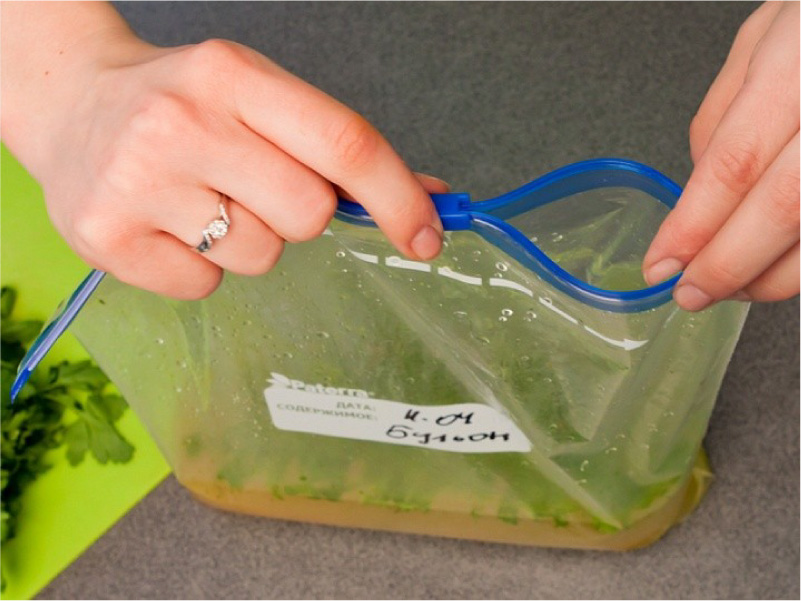
Special zip lock packages for freezing products with a label for signing dates and contents
The only thing that should not be stored in bags is sausages, meat, chicken, fish and cheese - in the film they will suffocate, get an unpleasant smell and quickly begin to deteriorate. It is better to transfer them from factory packaging in containers or wrap in paper / foil.
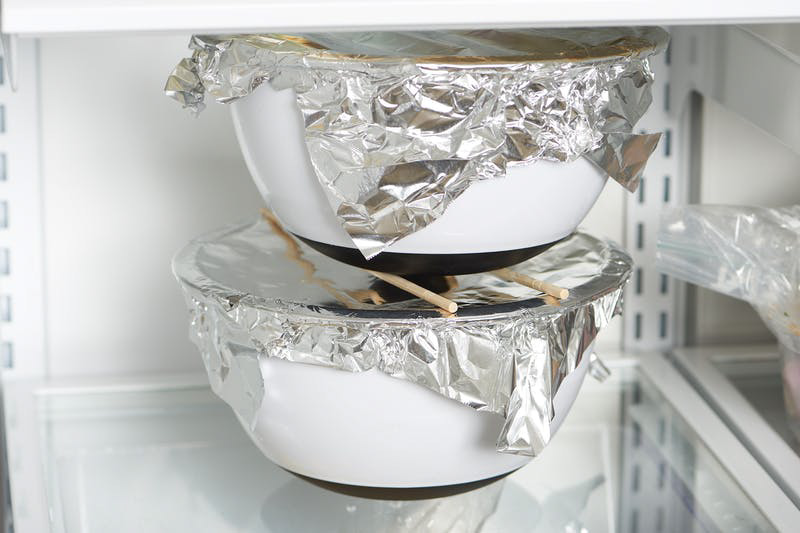
When there are not enough containers or zip-lok packages, ordinary plates and bowls help you, which you just need to cover with foil. To save space in the refrigerator, you can put dishes on top of each other, using Chinese chopsticks as a support.
Tip 2. Store greens, vegetables and fruits with paper napkins.
The main enemy of many vegetables, fruits and herbs - is high humidity in the refrigerator. To prolong the shelf life of the fruit, store them together with paper napkins or in paper bags - the paper will absorb condensate. This technique is especially needed if your refrigerator does not have a special freshness zone for fruits and vegetables.
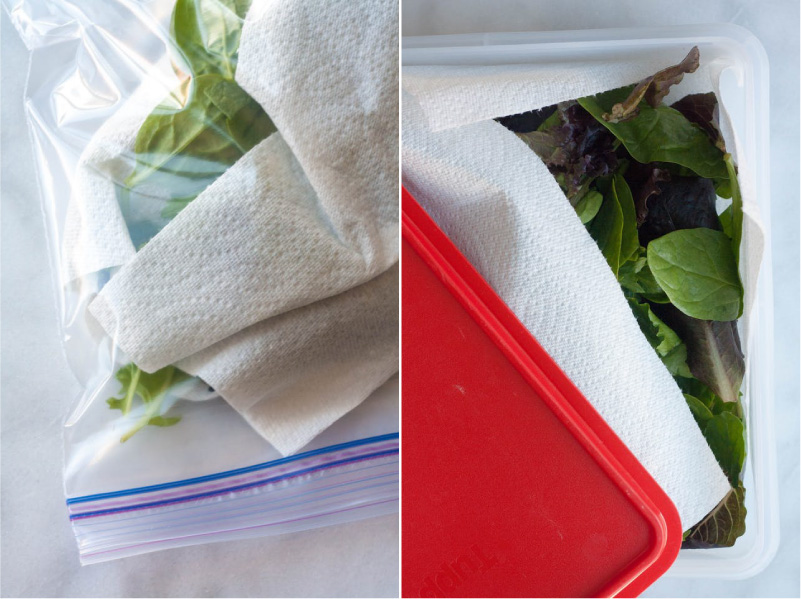
Tip 3. If you have to buy a new refrigerator, choose a model with a dry and wet zone of freshness.
Freshness zones are boxes in which perishable food can be stored for several days longer than in a conventional refrigerator compartment. Due to the lower temperature and the optimal level of humidity, the growth of microorganisms and bacteria slows down, but the food does not freeze.
For example, Bosch refrigerators with VitaFresh plus technology keep food fresh for up to 2 times longer. Just think how many advantages such a handicap of time gives:
- You can leave food at least a week and go to rest without throwing away food.
- Or imagine such a situation - in the afternoon you decided to prepare a new complex dish, bought ingredients, but by the evening the inspiration was gone. Do not worry - just fold the food in the zone of freshness and transfer the experiment to another day.
- For those who do not have the opportunity to cook daily, the freshness zone will allow to cook soups, lunches and dinners for several days in advance. In this case, the benefit and taste of the dishes do not have to sacrifice.
- Also, VitaFresh plus technology will allow you to go to the store no more than once a week. During this time, fruits and vegetables due to the natural level of humidity and the ability to regulate the access of dry air (we will tell about this option a little later) will not become watery and retain their vitamins. You can forget about meat with a smell that usually appears after 2 days.
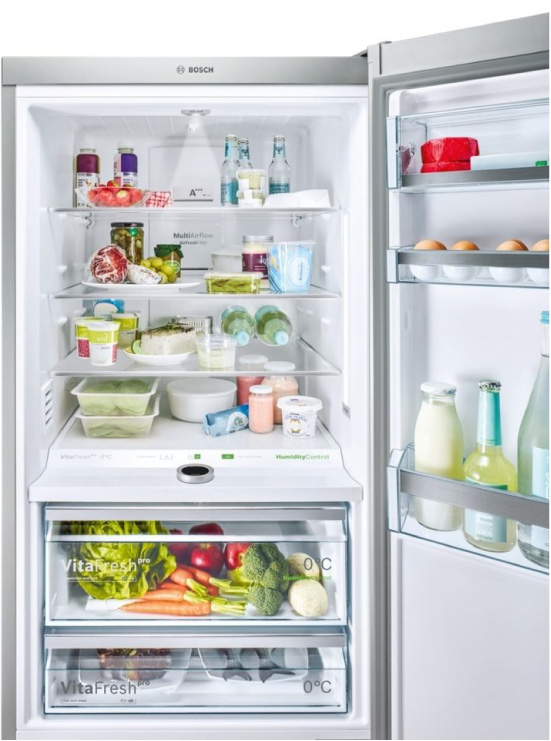
“Faded” salad, stuffed meat, tasteless vegetables and fruits - if there are freshness zones in your refrigerator, these problems will not arise for at least a week
The freshness zone in the refrigerator may be wet and / or dry.
- Wet zone is more intended for storage of fruits, vegetables and herbs.
- The dry zone maintains a temperature of about 0 degrees and is intended for meat, fish, poultry, dairy products. If desired, you can store and uneaten dinners and even cool drinks.
By the way, in Bosch refrigerators with VitaFresh plus technology (Serie | 6) you can use such life hacking - pull out boxes for meat and fish and put bottles with drinks instead. Because of the directional flow of cold, they cool down 3 times faster.
Tip 4. If your refrigerator has fresh areas with the ability to regulate access to dry air ... it's time to learn how to use it
So, you already have a fridge with a freshness zone in which you can regulate access to dry air. But do you really know how to use it? Or do you just set the average in the hope of the best? Understanding humidity settings will help you keep your fruits and vegetables longer and in top quality.
The principle of setting the humidity is quite simple.
- Low humidity needed for products that are insensitive to moisture loss. As a rule, these are fruits and vegetables that produce ethylene gas, for example, apples and pears. Having opened the access to the dry air in the “fruit” box, we give the ethylene the opportunity to get rid of it. This helps prevent premature fruit damage.
- High humidity mainly for storing leafy greens, such as arugula, spinach and herbs. When access to dry air is closed, the moisture is retained in the box and the greens are kept fresh and juicy. Along with greens, you can store fruits and vegetables that are sensitive to ethylene, such as strawberries.
Here is a handy plate with lists of products that prefer low or high humidity.
| High humidity storage | Storage in a low humidity drawer |
|---|---|
| Bananas (immature) | Apples |
| Broccoli | Avocado |
| Brussels sprouts | Bananas (ripe) |
| Cabbage | Melon (torpedo) |
| Carrot | Figs |
| Cauliflower | Honey melons |
| Cucumbers | Kiwi |
| Eggplant | Mango |
| Green bean | Papaya |
| Herbs (cilantro, dill, parsley, thyme) | Pears |
| Leafy greens (cabbage, salads, spinach, Swiss chard, watercress) | Apricots, nectarines, peaches, plums, etc. |
| Peas | |
| Pepper | |
| Strawberry | |
| Pumpkin, zucchini | |
| Watermelon |
An important point: freshness zones work best if they are at least two-thirds full. Perhaps this is a good motivation to eat more wholesome food.
Tip 5. Conduct a cursory examination of the refrigerator at least 3 times a week
Regularly inspecting the contents of the refrigerator, you will be able to timely detect the food that you need to eat as quickly as possible and to prevent the appearance of "illiquid".This is especially true for those products that we are used to buying for future use or in several forms. It can be yoghurts, sour cream, sauces, cottage cheese, cheese, milk or canned food.
To better manage supplies, stack expiring products in one place, for example, a transparent tray with the words “Eat me first!”.
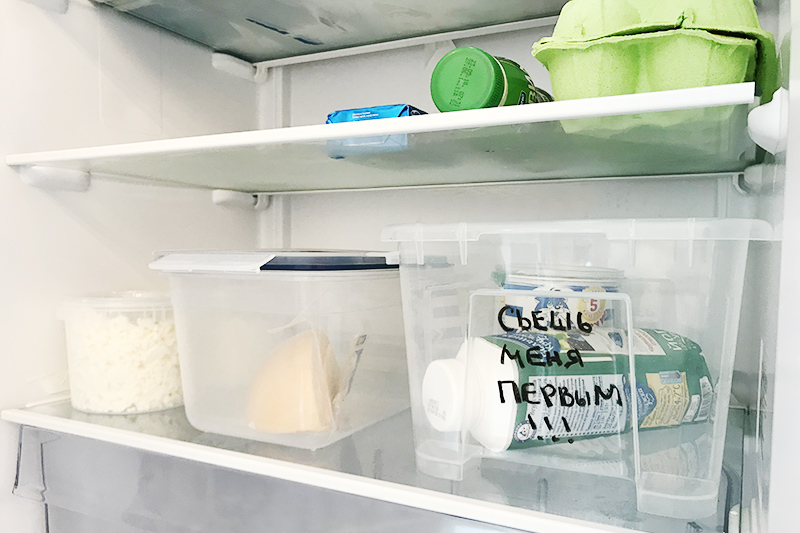
The idea of storing expired products
See also: Which refrigerator to choose: drip or know-frost?
Tip 6. If you are going on vacation, fill the refrigerator at least half
The fact is that an empty refrigerator works less efficiently. If the shelves of your device were empty, you can fill them with bottles of water.
By the way, it is also undesirable to overload the refrigerator, because for effective storage cold air should circulate freely around the chamber and around the products. If the movement of air slows down, the temperature will rise.
Tip 7. If possible, keep fruits and vegetables separately.
This will help to avoid mixing smells, and most importantly - will not allow the ethylene contained in many fruits, to speed up the damage to vegetables. Especially sensitive to this gas: potatoes, carrots, broccoli, asparagus and lettuce. And here is a list of leaders in the production of ethylene:
- Apples;
- Bananas;
- Pears;
- Peaches;
- Apricots;
- Kiwi;
- Mango.
Remember these fruits and never put them in the same box with vegetables and other ripe fruits.
Tip 8. If you need to extend the shelf life of bread and pastries, the refrigerator will help out.
If you need to leave, or you just bought too much bread, then extend his life as follows. Wrap the bread / pastry in a paper bag or plastic bag with small holes or in a bag made of natural fabric. If there is a freshness zone for fruit in the refrigerator, put the packaged bread in there. If there is no such box, then the top shelf of the refrigerator will do. So your bread and pastries can live for about 3 weeks. If necessary, flour products can be frozen for more than 1 month.
- To return the bread a pleasant softness after long storage in the refrigerator (or after freezing) it can be heated in a closed container in a microwave oven.
Tip 9. If you find spoiled fruits and vegetables, throw them away immediately.
Remember the saying about the rotten apple, which "spoils all the fruits in the basket"? This is really true. When buying fruits and vegetables (especially in containers), inspect the fruit. And if you find dubious copies rather throw them away.
Tip 10. If possible, buy products with a shelf life
Buying products, especially perishable, check their terms of production, shelf life and storage. Often in supermarkets the same goods on the same shelf may have different release dates.
Tip 11. Properly arrange the products
Returning from the supermarket with a weekly supply of products, many unload packages in a chaotic manner. As a result, after a few days, spoiled or dried snacks and food ingredients are found. All this happens because different temperatures are set in different zones of the refrigerator, and if the product gets into an unfavorable climate for it, it starts to deteriorate or lose its taste more quickly. Therefore, we advise once to remember a few simple recommendations and try to stick to them in the future.
- Top shelves - This is one of the warmest places in the fridge. It is well kept here: all kinds of leftovers, drinks and ready-to-eat foods (for example, butter, yogurt, cheese and delicacies).
- Bottom shelves - The lowest temperature is set here, so this zone is suitable for storing raw ingredients, that is, meat, fish, etc. (this advice is relevant if there is no special freshness zone in the refrigerator).
- Door - This is the warmest part of the refrigerator and, moreover, with an unstable temperature, so the habit of storing dairy products and eggs here should be discarded. But sauces and ketchups, jams and pickles, soft and melted cheeses will feel quite normal on the door shelves.
Tip 12. Do not store bananas, tomatoes in the refrigerator, and also ...
The secret of long-term storage of some products is to store them at room temperature. In addition to bananas and tomatoes, this list includes:
- Potato;
- Whole watermelons and melons;
- Whole garlic and onions;
- Chocolate;
- Coffee and tea.
These products become tasteless at low temperatures and deteriorate faster. Also outside the refrigerator you can store apples and not ripe solid fruits.
- What should be the temperature in the refrigerator?
- How to clean the pan outside and inside - 12 best ways
- How to clean the pan outside and inside - 8 simple ways for difficult cases
- How to wash the kitchen from grease and dirt - 11 recipes for different surfaces
- How to remove scale from the kettle - 6 home remedies
- We clean the hood from fat - quickly, simply, efficiently
- 8 ways to clean pipes from blockages

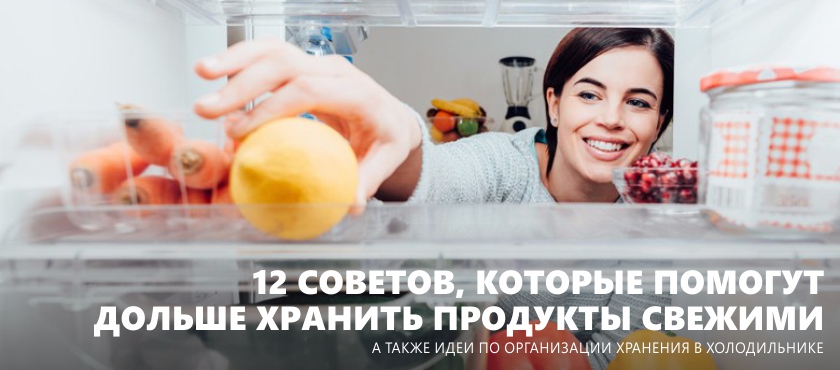
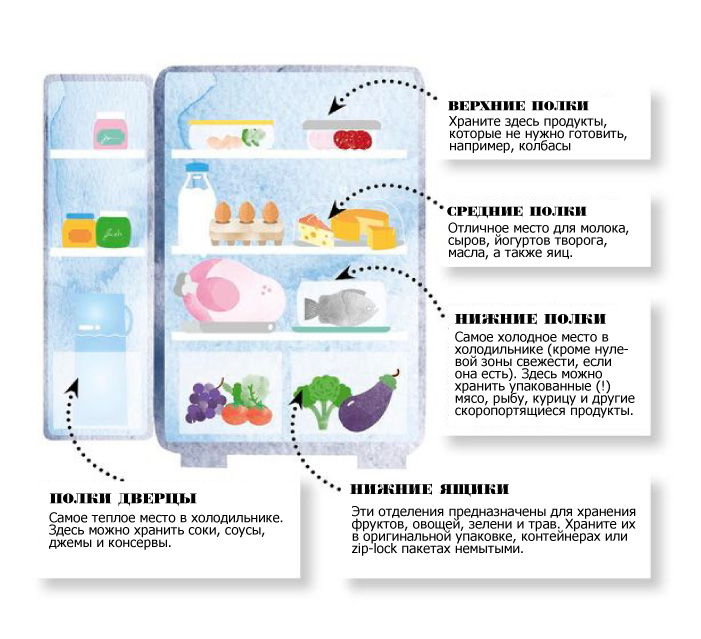

 (Rate the material! Already voted:16 average rating: 4,44 from 5)
(Rate the material! Already voted:16 average rating: 4,44 from 5)